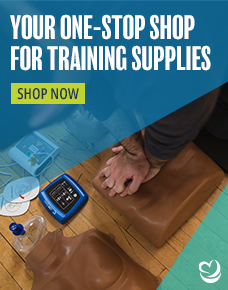
CAE Blue Phantom™ Thoracentesis and Thoracostomy Ultrasound Model
Dual-purpose training manikin for training clinicians in the psycho-motor skills associated with ultrasound guided thoracentesis and thoracostomy procedures
Blue Phantom’s ultrasound guided thoracentesis and chest tube thoracostomy training model allows users to develop and practice the skills necessary to gain proficiency in using ultrasound to identify and guide needle and catheter insertions in the patient with pleural effusions. This dual-purpose training mannequin is also designed to allow users to learn to perform chest tube thoracostomy utilizing non-ultrasoundable chest portals.
Two technologies are provided with the thoracentesis training model; an ultrasoundable tissue module and two non-ultrasound chest inserts. The ultrasound tissue module contains the chest wall, pleural cavity, lung, atelectatic lung, ribs, and a variety of pleural effusion fluid pockets. Two non-ultrasound chest portals located in the lateral chest and the anterior chest contain the skin layer, fat, ribs, and the pleural lining. Blue Phantom thoracentesis and thoracostomy training mannequin can be arranged in a variety of positions allowing users to learn how to perform procedures in the upright, supine, and right lateral decubitus positions. The ribs are palpable in both the ultrasound tissue insert and the non-ultrasound portals.
The two non-ultrasound chest portals are designed to help clinicians develop the skills necessary to place chest tube thoracostomies. These skills include performing intercostals incisions, blunt dissection of soft tissue down to the pleura, and placement of the chest tube into the pleural space. Because of the nature of placing large chest tubes into the portals, these portals are expected to endure 6–8 uses before requiring replacement.
This medical simulation trainer will perform well using any ultrasound imaging system configured with the appropriate transducer. This ultrasound phantom model is excellent for specialties including emergency medicine, critical care medicine, surgery, surgical training programs, ultrasound training programs, simulation centers, surgical skills centers, medical education facilities, and ultrasound manufacturers for ultrasound education and demonstrations.
- Ultrasound guided thoracentesis and blind insertion chest tube thoracostomy training model
- Excellent for training clinicians in the psycho-motor skills associated with ultrasound guided thoracentesis and thoracostomy procedures
- Imaging skills include:
- Using ultrasound system controls
- Transducer positioning and movement
- Recognition of thoracic anatomy, atelectatic lung, and pleural effusions
- Using ultrasound to target the appropriate fluid pockets for cannulation
- Performing an ultrasound-guided thoracentesis procedure
- User selected positioning; can be arranged in a variety of positions allowing users to learn how to perform procedures in the upright, supine, and right lateral decubitus positions
- Contains an ultrasound tissue module and two non-ultrasound chest portals (anterior and lateral positions)
- Ultrasound tissue module contains:
- Chest wall
- Pleural cavity
- Lung
- Atelectatic lung
- Ribs
- Variety of pleural effusion fluid pockets
- Non-ultrasound chest portals, designed for thoracostomy chest tube insertions contain the skin layers, fat, ribs, and pleural lining
- Superb ultrasound imaging characteristics
- Ultrasound tissue is ultra-durable; self healing tissue is extremely realistic in ultrasound imaging characteristics and feels like real human tissue
- Positive fluid flow offers users immediate feedback when pleural effusion fluid is accurately accessed in ultrasound tissue module
- Pleural fluid that is removed during thoracentesis procedural training is easily refilled using quick fill port
- Ultrasound tissues match the acoustic characteristics of real human tissue so when you use your ultrasound system on our training models, you experience the same quality you expect from imaging patients in a clinical environment
- Tissue inserts designed for needles and small catheters 18–21 gauge
- Performs well using any ultrasound imaging system
- High quality
- No special storage needs
- Patented technology
Includes:
- 1 bottle of simulated refill solution; one yellow 235mls bottle
Dimensions: 17” x 11” x 17” (43cm x 28cm x 43cm) (L x W x H)
Weight: 20 lbs. (9 Kg.)
Made in USA



